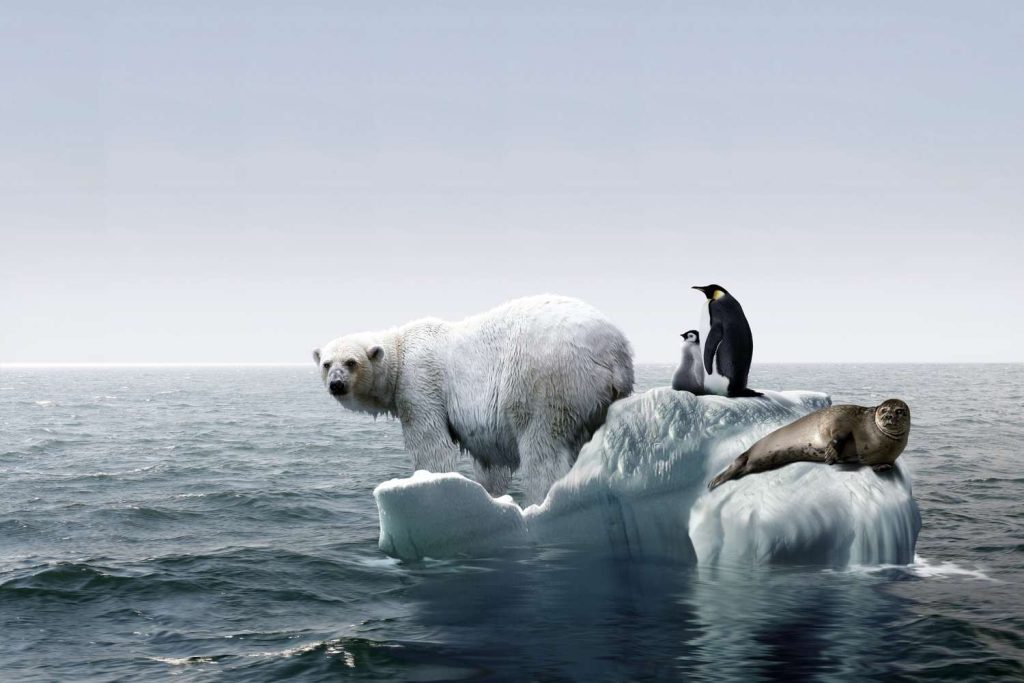
Melting glaciers and global warming: who suffers among animals?
Environmental experts have been warning about global climate change for decades. This phenomenon led to an increase in the average annual temperature, which caused the melting of glaciers and a rise in sea levels. The consequences of global warming can also be a decrease in the populations of various animal species and even a threat to human life. The editors of the RBC Life portal have collected forecasts from scientists from different parts of the world about what scenarios may unfold in the future.
Bumblebees
In a study published in the journal Nature, scientists warn of a potential threat to bumblebee species in Europe. Almost 80% of these insects’ habitats could shrink by a third by 2080. A group of scientists, led by Guillaume Giesbain from the Free University of Brussels, links this to global warming.
The study presents estimates that show that approximately 38% to 76% of bumblebee species not currently at risk of extinction will lose at least a third of their current ranges by 2080. This will particularly affect some pollinator species such as Bombus alpinus, Bombus flavidus and Bombus pyrrhopygus, whose ranges will be reduced by more than 90%.
To conduct the study, the scientists used a machine learning system that predicts changes in the populations of the most common bumblebee species in Europe depending on climate change. They analyzed data on how the habitat area of the 46 most common species of European bumblebees changed and compared them with changes in average temperatures.
The researchers concluded that even with a significant reduction in anthropogenic greenhouse gas emissions by 2061–2080, the 32% of bumblebee species classified as “least concern” would still lose at least 30% of the area suitable for their habitat. These results highlight the urgent need for action to protect biodiversity and maintain the important role of bumblebees in ecosystems.
Inhabitants of Antarctica
At the end of 2022, an article was published in the journal PLOS Biology containing an alarming forecast from scientists, environmental activists and politicians from 12 countries. A study involving American researchers predicts that up to 97% of Antarctica’s animals could die by 2100.
Scientists explained that such a grim scenario could become a reality if humanity fails to curb emissions of greenhouse gases, which cause the greenhouse effect and lead to global warming.
The authors of the study presented three possible scenarios. In the most favorable of them, about 37% of the fauna of Antarctica will die. However, according to scientific calculations, current conservation efforts are not sufficient, and therefore the current forecast suggests a loss of about 65% of animals. Losing ice threatens many species of seabirds, including Adelie penguins and emperor penguins.

Killer birds
Scientists from the University of Groningen in the Netherlands presented the results of their study, published in the journal Current Biology, which states that global warming is turning birds into aggressive killers. Their research shows that rising global temperatures are increasing competition among birds, making them violent and prone to attacking other birds during disputes over nests and food resources. This phenomenon can lead to a serious decrease in the number of pied flycatchers and even their complete disappearance.
Scientists also noted that due to climate change, pied flycatchers are returning to Europe earlier than usual, leading to increased competition with tits during the breeding season. Research indicates that one in 10 male pied birds fall prey to aggressive tits during conflicts over nests, which they call “nest war.”
Northern weasel
The northern weasel is facing the threat of extinction due to its color, which does not have time to adapt to climate change. Global warming has led to an early change of seasons, and the mammal does not have time to change its white color to brown after the snow melts. This white coloration makes the weasel more visible on the ground, making it a common prey for foxes, wolves and other predators, according to an article in Scientific Reports.
Scientists confirmed this fact as a result of experiments with mock-ups. They argue that camouflage plays a significant role in the animals’ ability to evade detection by predators. In addition, they emphasize that the process of adaptation to natural conditions took animals thousands of years, but has now become disproportionately fast, which does not allow them to adapt effectively within just a few decades.
People
Researchers at the University of Western Ontario in the UK warn that global warming could kill as many as a billion people over the next century. This estimate is based on estimates that for every 1,000 tons of greenhouse gases released from burning fossil fuels, there could be one premature death.
In addition, according to the latest forecast by researchers from the University of Washington, by 2200 the world’s population will reach 10.4 billion people. Consequently, losses due to climate change in the next century could amount to about 10% of the total human population by then.
Scientists emphasize that preventing dire consequences is possible if we strengthen energy conservation efforts and improve energy efficiency. They insist on a gradual transition to biofuels and renewable energy sources.
In addition, many experts predict that extreme heat will only increase in the coming years. This could result in Madrid’s climate in 2050 resembling North African Marrakesh, London’s Barcelona, and Stockholm facing temperatures similar to Budapest.
These findings confirm the need for immediate and consistent implementation of sustainable practices and environmental solutions in our daily lives. We understand that the challenges we face pose serious threats to our planet and future generations.
The Eco-guardians team will resolutely continue its mission of conserving nature, educating society about the importance of caring for the environment and finding innovative solutions to cope with the challenges of the environmental crisis. We believe that only through joint efforts can we preserve the unique beauty of our planet and ensure its prosperous future.